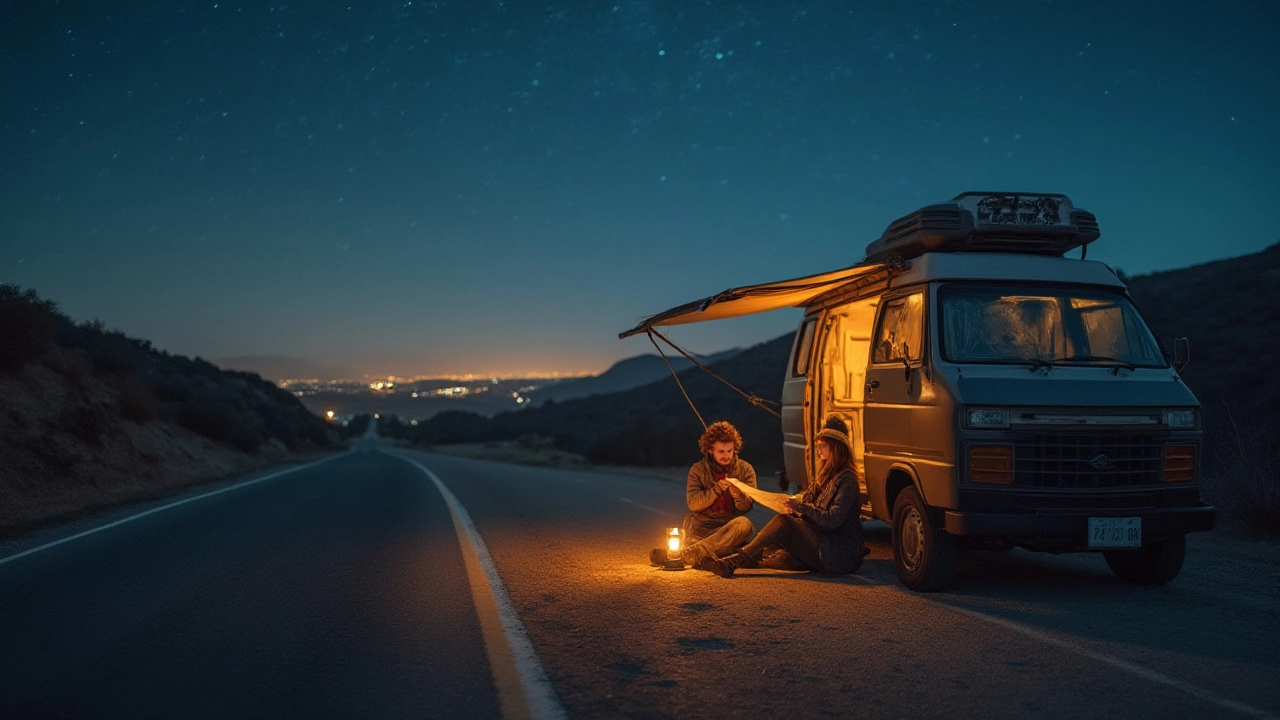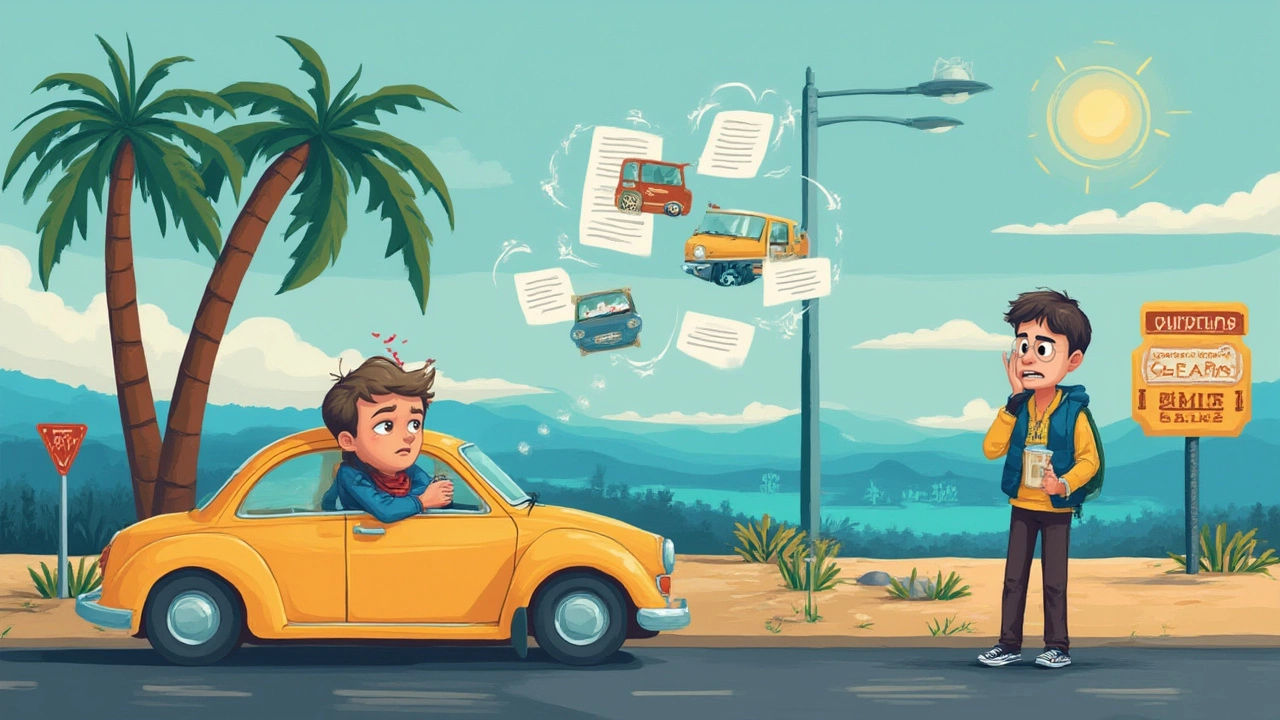Can You Legally Sleep on the Side of the Road in California? Rules, Risks, and Realities
 Jul, 31 2025
Jul, 31 2025
Picture this: You’re cruising the Pacific Coast Highway in the middle of the night, eyelids heavy, yawning every two minutes, miles from the next official campground. The only thing on your mind? Pulling over and catching a few hours of sleep. But here’s the million-dollar question: is it actually legal to sleep on the side of the road in California? A lot of folks assume it’s fine, but the full story is a maze of state laws, city ordinances, loopholes, and some serious grey areas.
Understanding California's Roadside Sleep Laws
Let’s cut to the chase: California state law does not have a blanket ban on sleeping in your vehicle. But — and it’s a big but — city and county rules often do. Roadside sleeping is a legal patchwork, so where you pull over makes a world of difference. Want to crash on a rural highway shoulder? The answer is different from snoozing in a busy urban area or tucked away in a leafy suburb.
The California Department of Transportation, better known as Caltrans, officially prohibits parking on the side of highways, except for emergencies. The California Vehicle Code (Section 22500) also makes it illegal to park in some places, like on bridges, in tunnels, and within intersections. City governments often go further, passing ordinances that ban overnight parking or sleeping in vehicles on public streets. By 2024, over 100 cities, including Los Angeles, San Diego, and San Francisco, had laws on the books banning sleeping in cars overnight unless you’re in a designated spot or under specific circumstances.
Signs make things clear sometimes, but not always. You might roll up to a quiet road, see no sign, and think it’s fine — but later find that the city’s website has an online map marking the area as a no-go for vehicle dwellers.
Law enforcement can ask you to move, issue a citation, or even tow your car if you ignore parking and sleeping ordinances. “Lots of people get confused or surprised by the patchwork of regulations,” says the American Civil Liberties Union (ACLU) in a 2023 report, going on to note, “even Californians wake up to a ticket on their windshield more often than they expect.” So, roadside sleeping often comes down to hyperlocal rules.
Here’s a taste of what can happen in different places:
- Big cities: Overnight car sleeping is usually banned on public streets.
- Rest stops: Caltrans allows up to 8 hours at rest areas, but camping is not allowed.
- Residential neighborhoods: Many cities prohibit sleeping in vehicles, especially in busy or high-value real estate zones.
- Highway shoulders: Legally, these are only for emergencies, with tickets for violators increasing each year.
- National forests/Bureau of Land Management (BLM) land: More forgiving, but there are still rules — like staying a set distance from water sources or roads.
The moral: Always check both state and local regulations before you even think about settling in. It takes two minutes online or one call to city hall to avoid a nasty surprise at sunrise.
The Realities and Risks of Roadside Sleeping
Okay, you’ve figured out whether the law technically lets you sleep in your rig for a night. But is it actually wise, comfortable, or safe? The risks can sneak up on you, whether you’re in a tricked-out Sprinter or just the backseat of your sedan.
First: break-ins and personal safety. Pulling over on a deserted stretch sounds romantic — until it’s midnight, headlights flash, and you wonder who else is out there. According to a 2022 AAA roadside safety report, the majority of car break-ins on highways happen after dark, usually when the vehicle is parked in an out-of-the-way spot for hours. People sleeping in cars run a higher risk of theft, unwanted attention, or run-ins with law enforcement.
Then there’s the tire-shredding issue of safety on highways themselves. Roadways designed for vehicles going 65 mph aren’t meant for parked cars, no matter how far you pull over. “Rest areas exist for a reason,” says CHP officer Julio Morales in a 2023 interview. “Highway shoulders are for breakdowns or emergencies. You’re putting yourself and other drivers at risk if you linger longer than you need to.” If a big rig drifts over the line at 3 a.m., you’re in its path.
And don’t forget the little stuff that adds up: weird noises, headlights flashing through the windows, engine fumes drifting in if you don’t pick your spot smartly. If you park on an incline, cars racing by shake your entire vehicle, making sleep nearly impossible.
Into the mix, add local homeless ordinances and anti-camping laws. In cities, savvy officers sometimes fine folks based not just on car parking, but loitering or vagrancy laws, especially if your vehicle looks lived-in or you’re parked in a neighborhood tired of van traffic. In 2023, Los Angeles issued tickets at a rate of 180 per day for illegal vehicle sleeping, according to city data. The trend runs state-wide in beach towns and mountain communities alike.
So if you’re looking for a guaranteed good night’s sleep, the random roadside usually isn’t the answer. Security, comfort, and legality just aren’t stacked in your favor.

Alternatives to the Side of the Road: Where You Can Actually Sleep
Look, nobody likes googling "where can I park and sleep legally near me" at one in the morning. But California has some solid alternatives if you’re willing to be creative or flexible. Roadside isn’t your only choice—sometimes it shouldn’t even be your last resort.
First up: rest areas. Caltrans operates dozens of these across the major interstates, and most let you stay for up to 8 hours. Grab a parking space, lock your doors, and you’re usually left alone unless you set up camp outside your car. Just don’t overstay — highway patrol is known for moving folks along who treat rest stops like free motels.
Some Walmarts, Cabela’s, or truck stops allow overnight parking, especially in less-populated areas. It’s always good form to step inside, buy a snack, and ask a manager first. Larger truck stops like Love’s and Pilot Flying J often set aside spaces for travelers with RVs or even regular cars. Early birds (or night owls) score the best spots.
Campgrounds, even basic or dispersed ones, are another option. National Forests and BLM land allow “dispersed camping” (that means away from developed sites), and the rules are much looser than in cities. Just stay away from busy recreation areas, clear marked no-camping zones, and always check for fire restrictions or local closures. You’ll have better luck in less densely populated chunks of the state — think Northern California, eastern Sierra, or the Mojave (if you can handle the heat).
Apps now make it way easier to plan ahead and find legal places to crash. Sites like iOverlander, FreeCampsites.net, and AllStays list not just campgrounds but every 24-hour rest stop, handy parking lot, or other legal option that past travelers have tested. User reviews make it easy to skip sketchy spots or ones where enforcement has ramped up. "Planning your parking spot ahead of time saves you a ton of hassle — and sometimes, money and headaches,” says Matt, a full-time van lifer featured in Outside magazine.
If you’re in an RV or camper, California has thousands of RV parks and campgrounds that welcome overnighters, though prices vary. Many of these have last-minute space even when regular tent sites are booked. It’s a step up in comfort and a huge step up for peace of mind.
| Location Type | Average Stay Allowed | Legality Risk | Notes |
|---|---|---|---|
| Highway Shoulder | Emergencies Only | High | State law prohibits except for emergencies |
| Rest Stop | Up to 8 hours | Low | No camping outside vehicle |
| Walmart/Truck Stop | 1 Night | Low-Medium | Check with management first |
| City Street | Varies (Usually None) | Medium-High | Check local ordinances |
| National Forest/BLM | Up to 14 Days | Low | Obey specific land use rules |
So before you resign yourself to the roadside sleep, try these safer, smarter, and usually legal options.
Tips, Tricks, and Roadside Realities: If You Must Sleep on the Road
Maybe you’re desperate. Maybe all the rest stops are packed, your navigation app’s giving you nothing, and you just can’t keep your eyes open. If you truly have to sleep roadside, use your head, not just your pillow.
- First, look for official pullouts or day-use areas. Sometimes you’ll find gravel stops, scenic overlooks, or unused construction turnouts. As long as you’re not blocking lanes and there’s no “no parking” sign, you’re less likely to get hassled for a few hours.
- Keep your car doors locked, windows up, and valuables tucked away—not just from thieves, but prying eyes. Cover windows with shades or privacy panels—and if you’re not prepared, a cheap towel or blanket gets the job done.
- If you leave your engine running for AC or heat, make sure the tailpipe isn’t blocked (carbon monoxide is no joke) and you’re someplace ventilated. If not, bundle up or layer down and shut it off.
- Don’t set up lawn chairs, lay out gear, or cook — that crosses the line from “traveler who needed a nap” into “illegal camping.”
- Move out early. The longer you linger after sunrise, the more likely you’ll get a knock at the glass from highway patrol or friendly locals.
- Be respectful. Stay quiet, keep your trash in your car, and don’t turn a one-hour pitstop into an eyesore that ruins things for the next tired traveler.
- And consider letting a friend or family member know where you are, especially if you’re truly in the middle of nowhere.
There are road warriors who make sleeping out of cars look glamorous on Instagram, but the not-so-glam part is hoarding trash, waking to tickets, and dodging headlights all night. By planning ahead and using common sense, you can avoid most headaches.
“Sleep is essential to safety on the road, but where and how you get it matters more than ever,” reminds the National Sleep Foundation. “Plan stops as part of your drive—not as an afterthought.”
If you play things smart, you can enjoy California’s wild beauty — without losing sleep over where to catch those Z’s. A little prep and respect for the rules go a long way.